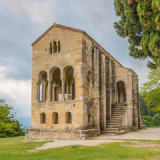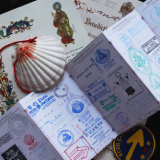
1/9
Camino Francés
In medieval times, this became the main pilgrimage route of the
Camino de Santiago and continues to be the most popular
nowadays. There are many reasons why it is the most well-known
route. Due to its connection with France, all pilgrims who came
from mainland Europe had to journey along this route. Moreover,
one of the chapters of the famous Codex Calixtinus contains a
guide to the Camino Francés, making it the only
documented route at that time. Later, due to the importance
given to it by the monarchy, the church or distinguished
visitors, it gained renown that was only marred by the Moorish
conquest in the XI Century.
This route starts from Saint Jean Pied de Port and travels
through northern inland Spain covering
764 km and 33 stages, passing through areas
such as Roncesvalles, Pamplona, Burgos and León, among many
others.
It is characterised as being
one of the routes with the most cultural and historical
heritage
for the previously mentioned reasons. Along the route you can
find magnificent cathedrals and famous churches. All this,
together with the wide range of services aimed at pilgrims, make
this one of the most highly-regarded routes.
Learn more

2/9
Camino Portugués
It began as a more commercial route following the independence
of Portuguese territory from Spain in the XII Century. Over
time, due to the renown achieved by the Cathedral of Santiago
and the remains of the apostle, this route began to be used by
believers who wanted to reach Santiago de Compostela and make
amends for their sins. Nowadays, it has become
one of the most important routes of the Camino,
being the second-most travelled by pilgrims after the French
route.
The Camino starts in Lisbon, the capital of Portugal, continuing
along a 620km route divided into 24 stages to
the Cathedral, entering Spanish territory in the Galician town
of Tui, one of the most sought-after starting points among those
pilgrims who are doing the Camino for the first time or who
don’t have enough time to complete the whole route.
This route stands out due to the combination of cultures it
features, as it crosses the
two linked territories of Spain and Portugal.
Considered one of the less challenging routes, this one is often
chosen by pilgrims wishing to avoid big hills or hard terrain
that can be found on other routes, such as the Camino Primitivo.
Learn more

3/9
Camino del Norte
This was the main alternative route at the time when the Camino
Francés was occupied by Muslim troops and therefore all
pilgrims, whether from Spain or the rest of Europe, had to
journey along this route, the only one which wasn’t occupied.
After the liberation of Spanish territory from the Moors at the
beginning of the XII Century, the French route began to gain
importance over the Northern route, although it continues to be
one of the most important to this day.
It begins in Basque territory, a community in the north of
Spain, specifically in the town of Irún. It is the longest route
(not including connections) given that it adds up to
820km divided into 32 stages, which travels
along all northern Spanish territory, which is why it is
sometimes also called the Camino de la Costa.
>Its
landscapes are without a doubt some of the most
beautifulamong all the Camino routes, connecting the sea views and
cliffs of the Cantabrian Sea beaches, with the green areas which
charcterise the north of Spain. Although there are some steep
climbs along the route, it is undeniably worth choosing this
route.
Learn more

4/9
Camino Primitivo
The first route in history. In the year 813, a rumour went
around that the tomb of the Apostle St. James had been
discovered in what was then known as Gallaecia territory (modern
day Galicia). King Alonfso II, the Chaste, went there to see if
the rumours were true. He set off from Asturias in the direction
of Santiago de Compostela, and the journey he made was
considered the first St. James pilgrimage,
which still exists nowadays under the name Camino Primitivo.
It starts in the Asturian capital of Oviedo, crossing the
autonomous community until it enters Galicia in the province of
Lugo, and finishing in Santiago after a journey of 313km and 11 stages.
Its route is one of the most demanding among the Caminos de
Santiago due to the fact that it crosses the mountainous region
between Asturias and Galicia. However, due to this same fact,
this route is
considered a route of personal growth and
moreover, is much less travelled. So if you wish to do a Camino
without large numbers of other pilgrims, this is the route for
you.
Learn more

5/9
Camino Inglés
Its name is closely linked to its history, given that due to the
importance of the maritime route between the British Isles and
Galicia centuries ago, many English sailors completed the
pilgrimage to pay their respects before the remains of the
Apostle. Such was its fame that there are documented events
whereby Crusaders and Templars stopped on Galician Coasts,
before traveling on to Jerusalem, in order to do the pilgrimage
to Santiago and ask the Apostle for protection in the Holy Land.
The route adds up to 120 km in 6 stages,
beginning in the port area of Ferrol. Curiously, this route also
offers another starting point, the city of A Coruña. Due to its
historic importance and its ties with the Galician capital, the
council of Santiago granted it the honour of being included in
the Camino, allowing pilgrims to obtain the much sought-after
Compostela, despite only consisting of 75km to Santiago (100km
is the minimum distance necessary to get the Compostela
otherwise).
The greenery and the Galician culture take precedence in this
route, which journeys through the depths of the autonomous community of
Galicia. If you want to appreciate the magic of this land, this route
is the option you should choose for your adventure on the Camino
de Santiago.
Learn more

6/9
Camino Portugués Along the Coast
>One of the youngest routes within the Camino network. It is
considered young as part of the itinerary within the Camino de
Santiago. However, history can prove that it is
a route as old as the classic Camino Portugués,
given that many distinguished people have carried out their
pilgrimmage along this route.
This itinerary stretches along the
280 kilometres that separate Porto from Santiago de
Compostela, in 9 stages
along the coast and 3 along the classic Camino. It is known as
the Camino Monacal, or the Monastic Camino due to the large
number of monasteries that can be found along the route.
In general, the route is flat and can be crossed all year round,
running between cliffs, mountains and estuaries. It starts in
the important city of Porto, and goes through towns such as
Póvoa de Varzim, Viana do Castelo, Esposende, A Guarda, Baiona
and so on.
Learn more

7/9
vía de la Plata
This started out as one of the most important roadways used by
the Ancient Roman Empire to connect Mérida with Astorga. Over
time, this roadway came to stretch from the south of Spain all
the way to the Galician capital, representing the route which
exists nowadays. Its connection with Santiago came about after
the Cathedral of Santiago was looted by Muslim troops, when the
bells of the temple were taken to Córdoba. After they were
recovered, following the fall of Al-Andalus in the Spanish
Reconquista, they were returned to their rightful place along
this route.
Upon reaching a certain point along this route, you have the
option of continuing and joining the Camino Francés, or
detouring at Puebla de Sanabria and continuing along the Camino
Sanabrés. Depending on which route you choose, the number of
kilometres travelled varies, however, it consists of
approximately 950km spread out over 27 stages,
making it the longest route with connections.
In the summer season, this route suffers high temperatures due
to the fact that it originates in the south of Spain, and there
are few places to sit in the shade and relax. Despite this,
every year it has more and more devotees due to
its status as a camino with a grand history and cultural
treasures.
Learn more

8/9
Camino de Invierno
During the winter season, the Camino Francés was hindered at
certain points due to heavy snows, and so pilgrims needed to
look for an alternative route that would expose them to less
risks. Their solution was that upon leaving Ponferrada, they
would detour to the southwest and avoid climbing to O Cebreiro,
among other challenges, and enter Galicia through the region of
Valdeorras, in the province of Ourense. Due to its origin in
avoiding the harsh winter, the Camino de Invierno was given its
name.
From the point of the detour in Ponferrada, this route continues
along 260km split into 8 stages until reaching
the Cathedral. This route offers an interesting curiousity,
unique among the other routes, in that along the journey, you
can cross all 4 provinces that make up the community of Galicia;
A Coruña, Lugo, Ourense and Pontevedra.
Despite what the its name might indicate, this route is not only
carried out in the winter months. Due to its landscapes and
cultural treasures, this route is journeyed by pilgrims all year
round.
Learn more

9/9
Camino a Finisterre
Fisterra, from the Latin finis terrae,can trace its roots to
long before the birth of the way to Santiago. Numerous studies
indicate that in this area, it was possible to connect the
ancient city of Dugium with the renowned Atlantis and the
settlement of a Celtic tribe called the “Nerios”. This is how a
multitude of settlements and cults began to proliferate in
honour of the sun god, who came to life again every day from the
depths of the waters of the Atlantic. The Apostle St. James
considered these cults to be pagan and ordered their
destruction. Faced with the villagers refusal to comply, it is
said that a huge flood washed away the village. All of this,
together with the miracles which occurred in Muxía, inspired
many pilgrims to prolong their adventure a little further upon
reaching Santiago.
This is the only route that doesn’t finish in Santiago de
Compostela, but rather starts there. There are
5 stages made up of a total of 120km as far as
Finisterre. This route is designed so that you can visit Muxía
along with Finisterre. If you hadn’t considered it, you should
think about it! Both regions posess a certain charm that
shouldn’t be missed.
Along this route you will have the opportunity to visit places
rooted in true Galician culture; it’s
an opportunity to get to know the charm of the Galician
community. Moreover, along the way, you can visit the Cascada del Ézaro,
the only waterfall in Europe that falls directly into the sea.
Learn more































